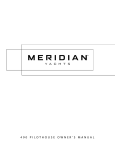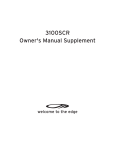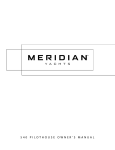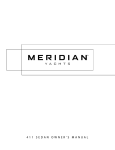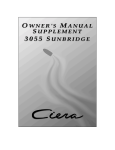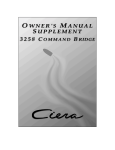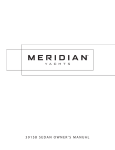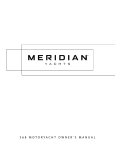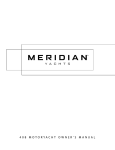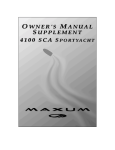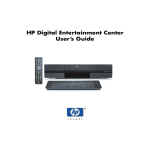Download Meridian Yachts Yacht Specifications
Transcript
Port Engine Serial Number: _________________________________________ Starboard Engine Serial Number: ____________________________________ Hull Identification Number: __________________________________________ Date of Purchase __________________________________________________ Hull Identification Number • The Hull Identification Number (HIN) is located on the starboard side of the transom. • Record the HIN (and the engine serial numbers) in the space provided above. • Please refer to the HIN for any correspondence or orders. © 2002 Meridian Technical Publications. All rights reserved. No part of this publication may be reproduced, stored in any retrieval system, or transmitted in any form by any means, electronic, mechanical, photocopying, recording or otherwise, without prior written permission of Meridian. Printed in the United States of America. General Notes The material in this document is for information only and is subject to change without notice. While reasonable efforts have bee n made in the preparation of this document to assure its accuracy, Meridian assumes no liability resulting from errors or omissions in this document, or from the use of information contained herein. Due to our commitment to product improvement, Meridian reserves the right to make changes in the product design, specifications, and equipment at any time without notice or obligation. Illustrations and/or photos may show optional equipment. All Meridian products meet or exceed USCG (Unites States Coast Guard) and/or NMMA (National Marine Manufacturer’s Association) construction standards. Manufactured with 1,1,1 Trichloroethane, a substance which harms public health and environment during the manufacturing process by destroying ozone in the upper atmosphere. Proprietary Rights This document discloses subject matter in which Meridian has proprietary rights. The information and design disclosed herein were originated by and are the property of Meridian. Neither receipt nor possession thereof confers or transfers any right to reproduce, copy, alter or disclose the document or any part thereof, any information contained therein, or to construct boats or any item from it, except by written permission from or written agreement with Meridian. This document is to be returned upon request to Meridian. CONTENTS 1 Chapter 1: Welcome Aboard! 13 Chapter 3: Controls 1 Dealer Service 13 Steering 1 About Your Express Limited Transferable Warranty 13 Autopilot (If Equipped) 14 1 Boating Experience Docking On Command (D.O.C.) System (If Equipped) 2 Engines & Accessories Guidelines 14 Shift/Throttle Controls 2 Engines & Accessories Literature 14 Trim Tabs 2 Safety Standards 3 Qualified Maintenance 15 3 Structural Limitations Chapter 4: Navigation & Communication Equipment 4 Boat Lifting 15 VHF Radio (If Equipped) 5 Special Care For Moored Boats 15 Compass 15 Radar (If Equipped) Carbon Monoxide (CO) 15 Depth Finder 7 7 7 16 Chapter 5: Plumbing 16 Bilge Pumps 5 6 Sacrificial Anodes (Zincs) Sources of CO Carbon Monoxide Alarm System What To Do If Carbon Monoxide Is Detected 8 Chapter 2: Propulsion & Related Systems 8 Engine 8 Exhaust System 9 Engine Room Ventilation System 10 Fuel System Fuel Fills & Vents Fuel Filters Fuel Transfer Pump (If Equipped) Anti-siphon Valves (If Equipped) 11 Oil Change System (If Equipped) 11 Fire Suppression System (If Equipped) 12 Shaft-Transmission Alignment 12 Shaft Log Packless Sealing System 12 18 Rudder Stuffing Gland Freshwater System 18 City Water Inlet 19 Water Heating Systems 19 Transom Shower (If Equipped) Engine Cooling System 8 10 10 11 11 16 Bilge Pump Testing 17 Autofloat Switches 20 Drain Systems 20 Deck Drains 20 Sink Drains 20 Shower Drain System 21 Seawater Systems 21 Seacocks 21 Seawater Strainers 22 Marine Head System 22 VacuFlush Head System (If Equipped) 23 Chapter 6: Deck Equipment 30 Chapter 10: Electrical System 23 Cleats 31 12-Volt DC System 23 Windlass (If Equipped) 24 Davit (If Equipped) 24 Canvas (If Equipped) 25 Chapter 7: Appliances & Entertainment Systems 31 31 31 31 32 32 33 Batteries Battery Switches Fuses and Circuit Breakers 12-Volt Accessory Outlet(s) Alternators Battery Charger or Inverter/Charger Alternating Current (AC) System 34 35 35 35 36 37 Shore Power Connecting To Shore Power Shore Power Cable Hoist (If Equipped) Inverter Power (If Equipped) Generator (If Equipped) Starting Generator 25 Audio & Visual Equipment 25 Dockside Television & Telephone Inlet 26 Propane System (If Equipped) 26 Propane Stove (If Equipped) 27 Electric Stove (If Equipped) 38 Important Records 28 Chapter 8: Lights 39 Float Plan 28 Care and Maintenance 28 Interior & Exterior Lights 28 Spotlight (If Equipped) 29 Chapter 9: Heating & Air Conditioning 29 Air Conditioning System (If Equipped) 29 Electric Heaters (If Equipped) 29 Heat Exchanger Cabin Heater (If Equipped) Hazard Boxes & Symbols The hazard boxes and symbols shown below are used throughout this supplement to call attention to potentially dangerous situations which could lead to either personal injury or product damage. Read ALL warnings carefully and follow all safety instructions. DANGE R! ! This box alerts you to immediate hazards which WILL cause severe personal injury or death if the warning is ignored. ! WARNING! This box alerts you to hazards or unsafe practices which COULD result in severe personal injury or death if the warning is ignored. ! CAUTION! This box alerts you to hazards or unsafe practices which COULD result in minor personal injury or cause product or property damage if the warning is ignored. NOTICE This box calls attention to installation, operation or maintenance information, which is important to proper operation but is not hazard related. FIRE HAZARD! EXPLOSION HAZARD! CO POISONING HAZARD! ELECTRICAL HAZARD! FALLING HAZARD! NO OPEN FLAME! HOT HAZARD! ROTATING PROPELLER HAZARD! RUN BILGE BLOWERS FOR 4 MINUTES! Meridian Yachts • Owner’s Manual Chapter 1: Welcome Abo ard! • This Owner’s Manual provides information about your yacht that is not covered in the Cruiser & Yacht Owner’s Manual Supplement. • Before using your yacht, study this Owner’s Manual, the Cruiser & Yacht Owner’s Manual Supplement, and all engine and accessory literature carefully. • Keep this Owner’s Manual and the Cruiser & Yacht Owner’s Manual Supplement on your yacht in a secure, yet readily available place. • When this owner’s manual went to press, wiring diagrams and systems views were not available. We apologize for any inconvenience this may cause. A Limited Edition, Captains Packet will be forwarded to you as soon as these diagrams and views are completed. Dealer Service • • • • • Ask your dealer to explain all systems before taking delivery of your yacht. Your dealer is your key to service. Contact your dealer if you have any questions or problems with your new yacht. If your dealer cannot help, call our customer service hotline: 360-403-2198 or send us a FAX: 360-403-1158. Buy replacement parts from any authorized Meridian dealer. About Your Express Limited Transferable Warranty • Meridian offers an Express Limited Transferable Warranty on each new Meridian purchased through an authorized Meridian dealer. • A copy of the Express Limited Transferable Warranty was included in your owner’s packet. • If you did not receive a copy of the Express Limited Transferable Warranty, please contact your dealer or call 360-403-2198 for a copy. Boating Experience ! WARNING! CONTROL HAZARD! A qualified operator must be in control of the yacht at all times. DO NOT operate your yacht while under the influence of alcohol or drugs. If this is your first yacht or if you are changing to a type of yacht you are not familiar with, obtain handling and operating experience before assuming command of the yacht. Take one of the boating safety classes offered by the U.S. Power Squadrons or the U.S. Coast Guard Auxiliary. For more course information, including dates and locations of upcoming classes, contact the organizations directly: • U.S. Power Squadrons: 1-888-FOR-USPS (1-888-367-8777) or on the Internet at: http://www.usps.org • U.S. Coast Guard Auxiliary: 1-800-368-5647 or on the Internet at: http://www.cgaux.org Outside the United States, your selling dealer, national sailing federation or local boat club can advise you of local sea schools or competent instructors. 1 CHAPTER 1: WELCOME ABOARD! Meridian Yachts • Owner’s Manual Engines & Accessories Guidelines NOTICE When storing your yacht please refer to your engine’s operation and maintenance manuals. • Your yacht’s engines and accessories were selected to provide optimum performance and service. • Installing different engines or other accessories may cause unwanted handling characteristics. • Should you choose to install different engines or to add accessories that will affect the yacht’s running trim, have an experienced marine technician perform a safety inspection and handling test before operating your yacht again. • Certain modifications to your yacht will result in the cancellation of your warranty protection. Always check with your dealer before making any modifications to your yacht. • The engines and accessories installed on your yacht come with their own operation and maintenance manuals. Read and understand these manuals before using the engines and accessories. Engine & Accessories Literature • The engine and accessories installed on your boat come with their own operation and maintenance manuals. • Read and understand these manuals before using the engine and accessories. • Unless noted otherwise, all engine and accessory literature referred to in this Owner’s Manual is included in your owner’s packet. Safety Standards ! DANGE R! R PERSONAL SAFETY HAZARD! DO NOT allow anyone to ride on parts of the yacht not designated for such use. Sitting on seat backs, lounging on the forward deck, bow riding, gunwale riding or occupying the transom platform while underway is especially hazardous and will cause personal injury or death. ! DANGE R! R PERSONAL SAFETY HAZARD! ALWAYS secure the anchor and other loose objects before getting underway. The anchor and other items that are not properly secured can come loose when the yacht is moving and cause personal injury or death. Your yacht’s mechanical and electrical systems were designed to meet safety standards in effect at the time it was built. Some of these standards were mandated by law, all of them were designed to insure your safety, and the safety of other people, vessels and property. In addition to this Owner’s Manual, please read the Cruiser & Yacht Owner’s Manual Supplement and all accessory literature for important safety standards and hazard information. 2 Meridian Yachts • Owner’s Manual CHAPTER 1: WELCOME ABOARD! Qualified Maintenance ! WARNING! To maintain the integrity and safety of your yacht, allow only qualified personnel to perform maintenance on, or in any way modify: The steering system, propulsion system, engine control system, fuel system, environmental control system, electrical system or navigational system. • Failure to maintain your yacht’s systems (listed in the warning above) as designed could violate the laws in your jurisdiction and could expose you and other people to the danger of bodily injury or accidental death. • Follow the instructions provided in the Cruiser & Yacht Owner’s Manual Supplement, this Owner’s Manual, the engine owner’s manual and all accessory literature. Structural Limitations The command bridge and the transom platform are designed to be lightweight for proper yacht balance. The load limit for these platforms is 30 pounds per square foot, evenly distributed. 3 CHAPTER 1: WELCOME ABOARD! Meridian Yachts • Owner’s Manual Boat Lifting ! WARNING! PERSONAL INJURY and /or PRODUCT OR PROPERTY DAMAGE HAZARD! • Lifting slings may slip on the hull. • Avoid serious injury or death by securing the lifting slings together before lifting. ! WARNING! PERSONAL INJURY and /or PRODUCT OR PROPERTY DAMAGE HAZARD! • NEVER lift the yacht using the bow and stern eyes. ! CAUTION! PRODUCT or PROPERTY DAMAGE HAZARD! • When lifting any yacht, always use a spreader bar. The spreader bar must be equal to the width of the yacht at each lifting point. • • • • 4 Always follow the lift equipment’s instructions and requirements. Water in the bilge can shift and change the balance of the load. If water is present in the bilge, pump or drain the water out of the bilge areas before lifting your yacht. When lifting your yacht, always position the lifting slings at the port and starboard, lifting sling label positions. Meridian Yachts • Owner’s Manual CHAPTER 1: WELCOME ABOARD! Special Care For Moored Boats NOTICE • To help seal the hull bottom and reduce the possibility of gelcoat blistering on moored yachts, apply an epoxy barrier coating, such as INTERLUX, Interprotect 2000E/2001E. The barrier coating should be covered with several coats of anti-fouling paint. • Many states regulate the chemical content of bottom paints in order to meet environmental standards. Check with your local dealer about recommended bottom paints, and about the laws in effect in your area. • Whether moored in saltwater or freshwater, your yacht will collect marine growth on its hull bottom. • This will detract from the yacht’s beauty, greatly affect its performance and may damage the gelcoat. • There are two methods of slowing marine growth: 1. 2. Periodically haul the yacht out of the water and scrub the hull bottom with a bristle brush and a solution of soap and water. Occasionally re-paint the hull below the waterline with a good grade of anti-fouling paint. Sacrificial Anodes (Zincs) NOTICE Do not paint between the zinc and the metal surface it contacts and do not paint over the zincs. NEW SACRIFICIAL ANODE DETERIORATED SACRIFICIAL ANODE Your yacht features sacrificial anodes (zincs) to protect underwater metal parts from excessive deterioration. Check the zincs regularly and replace them if they have deteriorated more than 70%. There are many factors that affect the rate at which the zincs deteriorate, including: • Water temperature • Salinity • Water pollution Stray electrical current from the yacht or dock may cause complete deterioration in just a few weeks. If there is rapid zinc deterioration, measure the electrolytic corrosion around your yacht with a corrosion test meter. If the zincs are not bonded correctly, they will not provide protection. 5 CHAPTER 1: WELCOME ABOARD! Meridian Yachts • Owner’s Manual Carbon Monoxide (CO) ! DANGE R! CARBON MONOXIDE POISONING HAZARD! DANGE R Carbon monoxide gas (CO) is colorless, odorless, and extremely dangerous. All engines, generators, and fuel burning appliances produce CO as exhaust. Direct and prolonged exposure to CO will cause BRAIN DAMAGE or DEATH. Signs of CO poisoning include: • Headache • Nausea • Dizziness • Drowsiness • • • • CO poisoning causes a significant number of boating deaths each year. Called the "silent killer", CO is an extremely toxic, colorless, odorless and tasteless gas. Breathing CO blocks the ability of your blood to carry oxygen. The effects are cumulative, even low levels of exposure can result in injury or death. Factors increasing the effects of CO poisoning include: • Age • Smokers or people exposed to high concentrations of cigarette smoke • Consumption of alcohol • Lung disorders • Heart problems • Pregnancy 6 Meridian Yachts • Owner’s Manual CHAPTER 1: WELCOME ABOARD! Sources of CO Sources of CO include: a. Using engine or generator when yacht is moored in a confined space. b. Mooring close to another boat that is using its engine, generator or any other CO source. c. Running yacht with trim angle of bow too high. d. Running yacht without through ventilation (station wagon effect). To correct stationary situations (a) and/or (b): • Close all the windows, portlights and hatches. • If possible, move your yacht away from the source of the CO. To correct running situations (c) and/or (d): • Trim the bow down. • Open the windows and the canvas. • When possible, run the yacht so that prevailing winds will help dissipate the exhaust. Immediately take corrective action if the CO is detected (see, Carbon Monoxide Alarm System, below). Carbon Monoxide Alarm System • Your yacht features a carbon monoxide (CO) alarm system. • Do not disconnect the alarm system. • Read and understand the manufacturer’s instructions for your CO alarm system. If you did not receive an instruction manual, call (800) 383-0269 and one will be mailed to you. • If your yacht is not equipped with a carbon monoxide alarm, consider purchasing one from your dealer or marine supply store. What To Do If Carbon Monoxide Is Detected • Immediately ventilate and evacuate any enclosed spaces that are occupied by people and reset your CO alarm. • Immediately move anyone showing any symptoms of CO poisoning into fresh air. • See a doctor if any symptoms persist. If the person is unconscious, immediately administer oxygen or CPR and call for emergency help. 7 Meridian Yachts • Owner’s Manual Chapter 2: Propulsion & Related System s Engine Read and understand the engine operation and maintenance manuals before using or working on the engines. Engine Cooling System ! CAUTION! SYSTEM DAMAGE HAZARD! The engine cooling system’s seacocks must be opened before engines are started and during engine operation. The engine cooling system circulates raw water around components and also uses a freshwater heat exchanger on the engine to reduce engine temperature. • Make sure both engine seawater intake valves (seacocks) are open before starting the engines and keep the seacocks open while the engines are running. • The cooling system’s seawater strainers should be checked for leaks and debris every time you use your yacht. For instructions on how to clean the seawater strainers, see the Seawater Systems section of this Owner’s Manual. Exhaust System ! DA N GE R! CARBON MONOXIDE POISONING HAZARD! Leaking engine and/or generator exhaust is a source of dangerous carbon monoxide gas (CO). Check all exhaust systems before each trip. • • • • • Look for leaks in the exhaust systems of the propulsion engines and the generator. Look for discoloration, water leaks, carbon or stains around all joints. Make sure all of the exhaust clamps are in place and secured. Make sure the ventilation systems work and are not obstructed or restricted. To reduce the chance of CO entering the living spaces, fill any gaps around engine room plumbing, cableways, exhaust systems, doors, hatches, and access panels. • The exhaust system is designed to keep seawater out of the engines in most sea conditions. • However, do not anchor the stern to sea or shut the engines off if high seas might flood the exhaust system. • Always consider the sea conditions before anchoring or shutting off the engines. 8 Meridian Yachts • Owner’s Manual CHAPTER 2: PROPULSION & RELATED SYSTEMS Engine Room Ventilation System ! • • • • WARNING! FIRE/EXPLOSION HAZARD Use of the blower system is NOT A GUARANTEE that explosive fumes have been removed. If you smell fuel, DO NOT start the engines or generator and DO NOT turn on any electrical devices. If you smell fuel and the engines and/or generator are already running, SHUT OFF the engines and/or generator and TURN OFF all electrical devices. Investigate immediately. DO NOT obstruct or modify the ventilation system. • The bilge blowers remove explosive fumes from the engine room. • Fresh air is drawn into the engine room through the deck vents. To make sure the engine room is properly ventilated: • Always run the bilge blowers for at least four minutes before starting the engines or the generator (if equipped). • Continue to run the blowers until your yacht has reached cruising speed. • Always run the blowers when operating the yacht below cruising speed. 9 CHAPTER 2: PROPULSION & RELATED SYSTEMS Meridian Yachts • Owner’s Manual Fuel System Carefully read the fuel section of both the Owner’s Manual and the engine operation manual, paying special attention to the subject of fuel recommendations. WARNING! ! FIRE, EXPLOSION AND OPEN FLAME HAZARD! • It is very important that the fuel system be inspected thoroughly the first time it is filled and at each subsequent filling. • The fueling instructions in the Owner’s Manual and the fuel recommendations in the engine operation manual must be followed. ! CAUTION! • Air in the diesel supply system can stop an engine or severely restrict performance. If you suspect air in the fuel lines, refer to your engine operation manual for detailed instructions on how to bleed the system. ! CAUTION Avoid the storage or handling of gear near the fuel lines, fittings and tank. Fuel Fills & Vents • The fuel fill fitting is marked “Diesel” or "Gas". • The fuel tank vent is located below the fuel fill. • If you have trouble filling a fuel tank, check to see that the fuel fill and vent lines are free of obstructions and kinks. Fuel Filters • The fuel pickup tube (located inside the fuel tank) is equipped with a fine mesh screen filter. • In addition, when supplied by the engine manufacturer, a fuel filter is installed on the engine. • Periodically replace the fuel filters to make sure they remain clean and free of debris. • Consult with your selling dealer or local marina concerning fuel additives that help to prevent fungus or other buildup in your fuel tank. 10 Meridian Yachts • Owner’s Manual CHAPTER 2: PROPULSION & RELATED SYSTEMS Fuel Transfer Pump (If Equipped) CAUTION! ! ENVIRONMENTAL HAZARD! NEVER transfer fuel into a full (or nearly full) fuel tank. Fuel transferred into a full tank will spill overboard through the tank venting system. Your yacht may feature a fuel transfer pump which pumps fuel from one tank to another. Anti-siphon Valves (If Equipped) NOTICE • If an engine running problem is diagnosed as fuel starvation, check the anti-siphon valve. • If the valve is stuck or clogged, change or replace it while the engine is shut down. • NEVER run an engine with the anti-siphon valve removed, except in an emergency. • • • • Gas fuel systems are equipped with anti-siphon valves. The valves are located at the point where the fuel feed line attaches to the fuel tank. The valves are spring loaded and are opened by fuel pump vacuum. This valves will prevent fuel from siphoning from the tanks in the event of a fuel line rupture. Oil Change System (If Equipped) Your yacht may feature an oil change pump to simplify draining and filling engine and generator oil. See the oil change system instructions for information on the use of this system. Fire Suppression System (If Equipped) Before using your boat for the first time, read and understand the fire suppression system’s instruction and maintenance manual and follow all warnings. Observe the following: • The system will go off automatically whenever direct heat from a fire is detected in the engine compartment. • The system can be set off manually by pulling the T-handle (labeled “FIRE”) at the helm. • The system can only be set off once during a fire. After the system is discharged it must be refilled and refurbished before it can be used again. 11 CHAPTER 2: PROPULSION & RELATED SYSTEMS Meridian Yachts • Owner’s Manual Shaft-Transmission Alignment ! CAUTION! SYSTEM DAMAGE HAZARD! • If you suspect a shaft-transmission misalignment, have a qualified mechanic perform an alignment inspection as soon as possible. • Continued use may lead to premature engine, transmission, shaft, shaft seal and/or hull damage! Alignment between the engine transmission output shaft and the propeller is very critical. The alignment has been performed at the factory and was rechecked by the dealer after the yacht had been in the water for 48 hours. • An alignment inspection should be performed by a marine mechanic as part of the routine maintenance program after the initial 30 hours of operation, then every 60 hours and whenever unusual noise or vibration is noticed. • Shaft-transmission alignment should be performed by a marine mechanic since it requires moving the engine and prop shaft. • To insure proper alignment after a haulout or dry storage, wait 48 hours after launching before final alignment adjustments by a marine mechanic are made. TRANSMISSION-TO-PROP SHAFT COMPONENTS (TYPICAL) CARBON/GRAPHITE FLANGE CLAMPS SECTION VIEW OF HULL TRANSMISSION OUTPUT FLANGE COUPLER ROTOR SHAFT BELLOWS SHAFT LOG (TRIANGLE FLANGE) CLAMPS FLANGE BOLTS Shaft Log Packless Sealing System The shaft log packless sealing system’s shaft seal is a maintenance-free, watertight seal that doesn’t require packing or adjustments. Rudder Stuffing Gland • The rudder stuffing gland is part of the assembly where the rudders emerge from the bottom of the yacht. • The shaft stuffing gland should not leak any water. • If a leak develops, it can usually be stopped by tightening the packing gland nuts slightly. Do not over tighten the packing gland nuts. • If stuffing gland leakage becomes excessive, packing replacement can be performed as follows: 1. 2. 3. 4. 5. 6. 7. 12 VIEW OF TYPICAL RUDDER SYSTEM TILLER ARM (TYPICAL) UPPER RUDDER BEARING SUPPORT (TYPICAL) RUDDER STUFFING GLAND (TYPICAL) Remove the yacht from the water. Loosen the packing gland nuts and back the packing gland from the sleeve. Remove the old packing. Wrap the new packing around the shaft. Cut the rings with a razor blade at an angle approximately 30 degrees to the long axis of the shaft. Stagger the ends of each ring around the shaft and insure that the rings are at the bottom in the sleeve. Tighten the packing gland nuts until resistance is felt. Meridian Yachts • Owner’s Manual Chapter 3: Controls Steering • This yacht features a power assisted rack-and-pinion steering system. • Check the fluid level in the power steering reservoir every time you use your yacht. • Yacht steering is not self-centering. Autopilot (If Equipped) ! WARNING! • Never leave the helm while the autopilot system is on! • A qualified operator must monitor the autopilot system at all times and keep lookout for other marine traffic and other hazards. NOTICE • Τhe autopilot system is only an aid to navigation. • It's accuracy can be affected by many factors, including equipment failure or defects, environmental conditions & improper handling or use. The autopilot will aid you in maintaining the chosen course of your yacht. 13 CHAPTER 3: CONTROLS Meridian Yachts • Owner’s Manual Docking On Command (D.O.C.) System (If Equipped) • Your yacht may feature a D.O.C. system which can be controlled from either helm. • The thruster(s) allow you to maneuver the yacht in close quarters when docking. • Read the thruster’s operation manual before using the thruster(s) for the first time. Shift/Throttle Controls ! WARNING! LOSS OF CONTROL HAZARD! Improper maintenance of shift/throttle hardware may cause a sudden loss of control! Read all of the information about the shift/throttle controls in the shift/throttle manual, the engine operation manual, and the Cruiser & Yacht Owner’s Manual Supplement. Trim Tabs ! WARNING! LOSS OF CONTROL HAZARD! Improper use of trim tabs will cause loss of control! • Do not allow anyone unfamiliar with trim tabs to use them. • Do not use trim tabs in a following sea as they will cause broaching or other unsafe handling characteristics. • Do not use trim tabs to compensate for excessive unequal weight distribution. • The trim tabs may be used to help keep your yacht level at cruising speeds. • The trim tabs are controlled by two rocker switches at the helm. • Before using the trim tabs read and understand the trim tab operation manual. Note the following: • Once cruising speed is reached, the port or starboard trim switch may be used (one at a time) to level the yacht. • Perform trim tab adjustment with several short touches to the switch rather than one long one. • After each short touch allow several seconds for the hull to react. • The trim tab hydraulic fluid reservoir is located in the engine compartment. The fluid level must be checked periodically (at least once a year) and refilled as necessary. 14 Meridian Yachts • Owner’s Manual Chapter 4: Navigation & Communication Equip men t Before using these systems for the first time, thoroughly read and understand the instruction manuals and observe the following: VHF Radio (If Equipped) • The VHF (Very High Frequency) radio can be used to access weather reports, summon assistance or contact other vessels as permitted by the FCC (Federal Communications Commission). • Contact the FCC for licensing, rules and regulations concerning VHF radio usage. Compass NOTICE • Compass accuracy can be affected by many factors. • Have a qualified technician calibrate your compass. Make sure the technician gives you a deviation card which shows the corrections to apply in navigational calculations. • Keep a copy of the deviation card at each helm. Radar (If Equipped) • The marine radar system gives you a complete and accurate 360° radar view of other vessels, buoys, and landfall surrounding your vessel. • To turn this system on, the RADAR switch on the DC breaker panel must be switched on. Depth Finder ! WARNING! • DO NOT use the depth finder as a navigational aid to prevent collision, grounding, yacht damage or personal injury. • When the yacht is moving, submerged objects will not be seen until they are already under the yacht. • Bottom depths may change too quickly to allow time for the yacht to react. • If you suspect shallow water or submerged objects, run the yacht at very slow speeds. 15 Meridian Yachts • Owner’s Manual Chapter 5: Plumbing Bilge Pumps • Your yacht is equipped with automatic bilge pumps which are used to pump water out of the bilge. • The bilge pumps are controlled by automatic bilge pump float switches (autofloat switches) and/or switches at the helm. • The bilge pumps are wired directly to the battery so they will normally function even when your yacht is completely shut down and left unattended. Bilge Pump Testing Bilge pumps are critical to the safety of your yacht. Check the bilge pumps often to make sure that they are working properly. Test each pump individually. To test each bilge pump: 1. 2. Turn on the manual switches at the helm. Make sure that water in the bilge is pumped overboard. If there is water in the bilge and the pump motor is running but not pumping: 1. Inspect the discharge hose for a kink or collapsed area. 2. Check the bilge pump housing for clogging debris as follows: To check for clogging debris in pumps: With your thumb and forefinger squeeze the holding tabs on each side of the power cartridge. 2. Lift out the power cartridge. 3. Check the pump and the housing and clear any debris. Reinstall the power cartridge: TAB 1. 1. 2. 16 Align the tabs and slots and press firmly until the tabs click into place. Make sure that the power cartridge is locked into place. SLOT (TYPICAL EACH SIDE) TABS Meridian Yachts • Owner’s Manual CHAPTER 5: PLUMBING Autofloat Switches • The automatic bilge pumps use float (autofloat) switches to automatically turn on the pumps whenever water accumulates above a preset level in the bilge. • The autofloat switches are normally mounted next to the bilge pumps they control. • The autofloat switches should be tested often for proper operation as follows. To test a float switch: 1. 2. 3. 4. 5. Turn on the float switch by twisting the white plastic knob 1/4 turn. The bilge pump should turn on. If twisting the knob does not turn the pump on, check the circuit breaker on the DC panel. If the circuit breaker is on, but the pump still does not work, it may indicate a bad switch or possibly a low battery. Release the knob to lower the float and return the float switch to auto mode. ! KNOBS AUTOFLOAT SWITCH CAUTION! When the test is completed on each float switch, you MUST push the test button all the way down to the auto position to return the switch to auto mode! 17 CHAPTER 5: PLUMBING Meridian Yachts • Owner’s Manual Freshwater System ! WARNING! • Only use safe drinking (potable) water in your yacht’s freshwater system. • Only use a sanitary drinking water hose to fill the water tank or connect to city water. • Never use a common garden hose for drinking water. • Read the Freshwater system section in the Cruiser & Yacht Owner’s Manual Supplement. • Your yacht is equipped with a pressure type (demand) freshwater (potable) system. • This system can be pressurized by turning on the water pump. Note the following about the freshwater system: • Turn off the water pump when the yacht is not in use or the water tank is empty. • Inspect and clean the water filter often (located on the water pump). • When your yacht is to be left unattended for long periods of time, pump the water tank dry to prevent stored water from becoming stagnant and distasteful. • If the freshwater system needs to be disinfected, ask your dealer about treatments available for your yacht’s system. • To winterize the freshwater system, pump the water tank dry and drain the system by opening the water filter. City Water Inlet ! CAUTION! FLOODING & SWAMPING HAZARD! NEVER leave the yacht unattended while using the "city water" feature. Any leak or break in the system may allow large amounts of water to accumulate in the bilge that could cause swamping of the batteries and engines or sinking of the yacht. • Read the "City Water Hookup" portion of the Freshwater System section in the Cruiser & Yacht Owner’s Manual Supplement. • When the yacht is connected to a dockside water supply, the freshwater system is pressurized. • You do not need to turn on the water pump’s DC breaker, located on the DC panel. 18 Meridian Yachts • Owner’s Manual CHAPTER 5: PLUMBING Water Heating Systems ! WARNING! SCALDING HAZARD! • Water heated by the water heater can be hot enough to scald the skin. ! CAUTION! WATER HEATER DAMAGE HAZARD! • DO NOT turn on the water heater electrical circuit on the AC panel until the water heater tank is COMPLETELY filled with water. • Even momentary operation in a dry tank will damage the heating elements. • Warranty replacements WILL NOT be made on elements damaged in this manner. • The tank is full if water flows from the tap when the hot water is turned on in the galley. • The water heater should be drained and the power turned OFF when the possibility of freezing exists. NOTICE If your yacht is connected to shore power or generator power, but the water heater is not working: • Make sure the water heater circuit breaker on the AC panel is switched ON. If the circuit breaker on the AC panel is ON, but the water heater is still not working: • Consult with your dealer about checking the "push to reset" circuit breaker located on the water heater. • Read the water heater instruction manual and heed the warnings above. • The water heater is connected to the AC power system. • Turn on the water heater breaker on the AC panel to heat the water. Transom Shower (If Equipped) • Your yacht features a freshwater transom shower. • Read the manufacturer’s instructions before using the transom shower for the first time. • The water pump switch must be turned on before using the transom shower. 19 CHAPTER 5: PLUMBING Drain Systems Deck Drains • Water on the deck is drained overboard through the deck drains. • Keep the deck drains free of debris. Sink Drains Gray water (water from the sinks) is gravity drained overboard. Shower Drain System • The shower is drained into a sump box. • A float switch automatically turns on the sump pump. • The sump pump pumps the shower water overboard. 20 Meridian Yachts • Owner’s Manual Meridian Yachts • Owner’s Manual CHAPTER 5: PLUMBING Seawater Systems Seacocks ! CAUTION! SYSTEM DAMAGE HAZARD! • Before using a seawater intake system, make sure that the system’s seacock is in the OPEN position before the system is started and keep the seacock open until the system is shut off. • Close the seacocks whenever the systems will not be used for long periods of time. A seacock is a valve, controlled by a 90º lever, used to manage SEAWATER INTAKE VALVE (SEACOCK) the intake of seawater through the hull and below the water COMPONENTS (TYPICAL) line. Seacocks are typically used on your yacht in the following seawater intake systems: 90 DEGREE SEACOCK (TYPICAL) SEACOCK • Engines LEVER SEACOCK GASKET • Generator (if equipped) HULL • Marine head (toilet) SECTION INTAKE STRAINER • Air conditioning system (if equipped) Before using any of these systems, make sure that the system’s seacock is open and remains open until the system is shut off. Seawater Strainers • Seawater strainers are used in water pickup systems to filter incoming seawater. • A seawater strainer is located near each system’s seacock. • Check the strainers for leaks and/or debris every time you use your yacht. • If debris is found, clean the seawater strainer as follows: ! CAUTION! FLOODING HAZARD! • The seacock that sends seawater to the strainer must be CLOSED before disassembling the seawater strainer to prevent the yacht from taking on water through the seawater strainer assembly. • Keep the seacock CLOSED until the seawater strainer is completely reassembled. SYSTEM DAMAGE HAZARD! • After reassembling the seawater strainer, make sure that the seacock valve is OPEN before using the component/system. 1. 2. 3. 4. 5. 6. 7. Make sure the component/system (generator, air conditioning system, etc.) that the strainer is connected to is turned off. Close the seacock that sends seawater to the strainer you are about to clean. The seacock must remain closed until the strainer is completely reassembled. Take apart the seawater strainer. Remove the debris. Flush the strainer with water. Reassemble the seawater strainer. Open the seacock and check for leaks around the strainer. If no leaks are found, you may use the component or system. 21 CHAPTER 5: PLUMBING Meridian Yachts • Owner’s Manual Marine Head System NOTICE Check with local authorities for regulations regarding the legal use of marine head systems. • • • • Read the marine head operation and maintenance manual before using the marine head for the first time. The holding tank is plumbed to a waste fitting on the deck for dockside pump-out. Check the content level of the holding tank by looking at the digital tank monitoring system. Empty the holding tank at every opportunity. To use the macerator to pump waste directly into the water (where regulations permit): 1. Open the underwater discharge seacock. 2. Press both macerator switches at the same time to run the pump. Do not continue running the macerator if the waste holding tank is empty. 3. Close the underwater discharge seacock when you are done pumping. Winterizing The Marine Head 1. 2. • • Shut off the intake seacock and pump until the bowl is dry. Remove the drain plug in the base and pump again to remove all of the water. Do not fill the bowl with anti-freeze. Close the intake seacock while the yacht is underway or whenever the yacht is left moored in the water. VacuFlush Head System (If Equipped) The VacuFlush head system uses freshwater from the water tank and a vacuum generator to flush waste from the toilet into the holding tank. The holding tank is plumbed to a waste fitting on the deck for dockside pump-out. 22 Meridian Yachts • Owner’s Manual Chapter 6: Deck Equipm ent Cleats ! WARNING! PERSONAL INJURY and /or PRODUCT or PROPERTY DAMAGE HAZARD! • NEVER lift the yacht using the cleats. Carefully read the section on towing in the Cruiser & Yacht Owner’s Manual Supplement before towing anything behind the yacht or having the yacht towed by another vessel. Windlass (If Equipped) ! CAUTION! PRODUCT DAMAGE HAZARD! • DO NOT pull the yacht to the anchor using the windlass or continue to run the windlass if it has stalled or is overloaded. • • • • • • Your yacht may feature an anchor windlass. Read and follow the manufacturer’s instruction manual before using the anchor windlass for the first time. The windlass can be controlled from a switch at the helm or from the deck foot switches. Turn on the windlass breaker before using the anchor windlass. To haul the anchor, use engine power (not the windlass) to move the yacht to, and directly above, the anchor. Use the windlass to dislodge the anchor from the bottom by pulling it straight up. 23 CHAPTER 6: DECK EQUIPMENT Meridian Yachts • Owner’s Manual Davit (If Equipped) ! WARNING! PERSONAL INJURY and /or PRODUCT or PROPERTY DAMAGE HAZARD! • Water is heavy. Lifting a dinghy to drain its bilge may exceed the davit’s load limit. • Also, use extreme care when using the davit in rough weather or sea conditions as the load may swing out of control. ! WARNING! PERSONAL INJURY, FALLING HAZARD! • Falling from a suspended boat may cause injury or death. • Do not allow passengers in a suspended boat. • Davit load not to exceed 750 lbs. • Only use the davit when it is securely locked in the upright position. • Before using the davit read the davit’s operating instructions and heed the warnings above. • Make sure that the davit breaker is turned on before using the davit. Canvas (If Equipped) ! CAUTION! Take down and securely stow the convertible top, side curtains and back cover before transporting your yacht by road. 24 Meridian Yachts • Owner’s Manual Chapter 7: Appliances & Enter tainm ent System s NOTICE Always keep an approved ABC-type fire extinguisher in galley area. All appliances installed on your yacht come with their own manuals. These manuals contain detailed instructions and important safeguards. Thoroughly read and understand these manuals before using your yacht’s appliances. • Make sure the AC breaker is turned on for the appliance you wish to use. Audio & Visual Equipment NOTICE AM radio reception may be impaired anytime the engine is running. Read the instruction manuals for all of the audio & visual equipment before using this equipment for the first time. Dockside Television & Telephone Inlet To use a telephone or receive cable TV transmission, the yacht must be hooked up to a dockside source using the TV/ telephone inlet. 25 CHAPTER 7: APPLIANCES & ENTERTAINMENT SYSTEMS Meridian Yachts • Owner’s Manual Propane System (If Equipped) ! DANGE R! CARBON MONOXIDE POISONING HAZARD! The propane stove is a potential source of dangerous carbon monoxide gas (CO). Do not operate without adequate ventilation. Before using the propane system read the propane stove operating instructions. Propane Stove (If Equipped) ! DANGE R! CARBON MONOXIDE POISONING HAZARD! • The propane stove is a source of dangerous carbon monoxide gas (CO). • BEFORE using the propane stove, open doors and windows to make sure there is enough fresh air for ventilation. ! WARNING! • Open flame cooking appliances consume oxygen, this can cause asphyxiation or death. • Maintain open ventilation. ! • • • • • • 26 WARNING! BURN/SCALDING and/or FIRE HAZARD! Read the stove’s instruction manual before using. Always keep an approved ABC-type fire extinguisher in galley area. Do not use the stove while underway. Any non-cooking devices on or near your stove during use are potential fire hazards! DO NOT touch burners, grates or nearby surfaces as they may be hot even when they are dark in color. Areas near burners and grates may become hot enough to cause burns. During and after use, do not touch or let clothing or other flammable material come in contact with heated units or areas near the units (burner tops, main frame sides and back, sea rails and pot holders) until they have had sufficient time to cool. Meridian Yachts • Owner’s Manual CHAPTER 7: APPLIANCES & ENTERTAINMENT SYSTEMS Electric Stove (If Equipped) ! • • • • • • WARNING! BURN/SCALDING and/or FIRE HAZARD! Read the stove’s instruction manual before using. Always keep an approved ABC-type fire extinguisher in galley area. Do not use the stove while underway. Any non-cooking devices on or near your stove during use are potential fire hazards! DO NOT touch burners, grates or nearby surfaces as they may be hot even when they are dark in color. Areas near burners and grates may become hot enough to cause burns. During and after use, do not touch or let clothing or other flammable material come in contact with heated units or areas near the units (burner tops, main frame sides and back, sea rails and pot holders) until they have had sufficient time to cool. 27 Meridian Yachts • Owner’s Manual Chapter 8: Lights Care and Maintenance All of the lights installed on your yacht are of top quality, but you should be aware that failure may periodically occur for a variety of reasons: 1. 2. 3. 4. There may be a blown fuse - replace the fuse. The bulb may be burned out - carry spare bulbs for replacement. A wire may be damaged or may have come loose - repair as required. The bulb base may be corroded - clean the base and coat it with non-conductive electrical lubricant. Interior & Exterior Lights ! CAUTION! • Be conservative in the use of battery power. • Prolonged use of cabin interior lights (overnight) will result in a drained battery. • • • • The lights are powered by the yacht’s 12-volt or 24-volt DC system. The house battery switch must be in the ON position for the lights to work. There are ON/OFF light switches for different sets of lights on the cabin wall. Some individual lights also have a switch on the light. Spotlight (If Equipped) Read the spotlight operating instructions before using the spotlight. 28 Meridian Yachts • Owner’s Manual Chapter 9: Heating & Air Conditioning Air Conditioning System (If Equipped) ! DANGE R! CARBON MONOXIDE POISONING HAZARD! Dangerous carbon monoxide gas (CO) can be brought into the yacht through the air conditioning system. ! CAUTION! SYSTEM DAMAGE HAZARD! The air conditioning system’s seacock must be OPENED before turning on the air conditioner and must remain OPEN during use. Read the air conditioner manual before using the air conditioning system. • Before using the air conditioning system, make sure the breakers on the AC main distribution panel are turned on and make sure the system’s seawater pickup seacock is open. The seacock must remain open anytime the air conditioner is in use. • The seawater pickup strainer should be checked for debris according to the directions given in the Seawater Strainer section of this Owner’s Manual. Electric Heaters (If Equipped) • Your yacht may feature electric cabin heaters. • Before using the electric heaters, read the electric heater’s instruction manual. • Before using the electric heaters, make sure the breakers on the AC panel are turned on. Heat Exchanger Cabin Heater (If Equipped) Your yacht may feature a heat exchanger cabin heater. This heater runs directly off the port engine. Before using the heat exchanger cabin heater: 1. Read the manufacturer’s instruction manual. 2. Make sure the circulation loop shut-off valve is open. 3. Turn on the circuit breaker for the heater fan. • If the heat exchanger circulation loop is open and the port engine is running, the heater will radiate heat even if the heater fan is turned off. • All circulation to the heater can be shut off by closing the circulation loop shut-off valve. 29 Meridian Yachts • Owner’s Manual Chapter 10: Electrical System ! DANGER! EXTREME FIRE, SHOCK & EXPLOSION HAZARD! • To minimize the risks of fire and explosion, NEVER install knife switches or other arcing devices in the fuel compartments. • NEVER substitute automotive parts for marine parts. Electrical, ignition and fuel system parts were designed and manufactured to comply with rules and regulations that minimize risks of fire and explosion. • DO NOT modify the electrical systems or relevant drawings. • Have qualified personnel install batteries and/or perform electrical system maintenance. • Make sure that all battery switches are turned OFF before performing any work in the engine spaces. ! WARNING! FIRE & EXPLOSION HAZARD! • Fuel fumes are heavier than air and will collect in the bilge areas where they can be accidently ignited. • Visually and by smell (sniff test), check the engine and fuel compartments for fumes or accumulation of fuel. • ALWAYS run the bilge blowers for at least four minutes prior to engine starting, electrical system maintenance or activation of electrical devices. • Minimize the danger of fire and explosion by not exposing the batteries to open flame or sparks. NEVER smoke anywhere near the batteries. ! CAUTION! SHOCK & ELECTRICAL SYSTEM DAMAGE HAZARD! NEVER disconnect the battery cables while the engine is running since it can cause damage to your yacht’s electrical system components. NOTICE Electrical connections are prone to corrosion. To reduce corrosion caused electrical problems, keep all electrical connections clean and apply a spray-on protectant that is designed to protect connections from corrosion. 30 Meridian Yachts • Owner’s Manual CHAPTER 10: ELECTRICAL SYSTEM 12-Volt DC System Batteries The batteries supply electricity for lights, accessories, and engine starting. The Electrical section of Chapter 8, in the Cruiser & Yacht Owner’s Manual Supplement, provides battery, care and maintenance instructions. Battery Switches ! CAUTION! • Never disconnect the battery cables or turn off the main battery switches while engines are running as this can cause damage to your boat’s electrical components • A separate battery switch is provided for each battery (or battery bank). • The batteries supply electricity for lights, 12-Volt accessories, and engine and generator starting. • "Stand-by loads", such as the CO monitors, the automatic bilge pumps, and the stereo memory, are not affected by the battery switches. Stand-by loads bypass the battery switch and are wired directly to the battery. Fuses and Circuit Breakers • Fuses and circuit breakers for engines and main accessory power are on the DC distribution panels and on the battery switch panel. • Some equipment may have secondary fuse protection at the unit, behind the battery switch panel or at the batteries. • Electronics power is provided at the helm station. 12-Volt Accessory Outlet(s) ! CAUTION! DO NOT use the 12-volt accessory outlet with a cigarette or cigar lighter. High temperatures may melt the outlet. • Your boat features one or more 12-volt accessory outlets. • The outlet can be used with any 12-volt device which draws 15 amps or less. • The 12-volt accessory outlet is protected by a 15 amp circuit breaker on the main circuit breaker panel. 31 CHAPTER 10: ELECTRICAL SYSTEM Meridian Yachts • Owner’s Manual Alternators The engine alternators will keep the batteries properly charged when running at cruising speeds. Battery Charger or Inverter/Charger ! CAUTION! The battery charging systems (alternator and battery charger or inverter/battery charger) installed on your yacht are designed to charge conventional lead-acid batteries. Before installing gel-cell or other new technology batteries, consult with the battery manufacturer about charging system requirements. • Before using the battery charger or the inverter/battery charger, read all instructions and cautionary markings on (1) the battery charger or the inverter/battery charger, (2) the batteries, and (3) all appropriate sections of the battery charger manual or the inverter/battery charger manual. • The battery switches do not need to be ON when using the battery charger or the inverter/battery charger. • You may use DC powered electrical systems, such as the lights and stereo when the battery charger or the inverter/ battery charger is on, but there will be a corresponding drop in charger performance. 32 Meridian Yachts • Owner’s Manual CHAPTER 10: ELECTRICAL SYSTEM Alternating Current (AC) System ! CAUTION! WATER HEATER DAMAGE HAZARD! • DO NOT turn on the water heater circuit breaker, on the AC panel, until the water heater tank is COMPLETELY filled with water. • The tank is full if water flows from the tap when the hot water is turned on in the galley. • Even momentary operation in a dry tank will damage the heating elements. • Warranty replacements WILL NOT be made on elements damaged in this manner. NOTICE Whether using shore power or generator power, the simultaneous use of several AC components can result in an overloaded circuit. It may be necessary to turn off one or more accessories in order to use another accessory. • Τhe AC system can be energized by shore power, generator power (if equipped), or inverter power (if equipped). • The master circuit breakers, located on the AC panel, provide power source selections to AC powered accessories. Individual breakers must be turned on to supply power to the accessories you wish to use. • The AC panel may contain inactive circuit breakers for accessories that were either options or were not offered for this model yacht. 33 CHAPTER 10: ELECTRICAL SYSTEM Meridian Yachts • Owner’s Manual Shore Power ! • • • • • DANGE R! FIRE, EXPLOSION & SHOCK HAZARD! DO NOT alter shore power connectors and use only compatible connectors. Before plugging in or unplugging the shore power cord to your boat, make sure all breakers and switches on the AC master panel are turned OFF. To prevent shock or injury from an accidental dropping of the “hot” cord into the water, ALWAYS plug the shore power cord to the boat inlet first; then to the dockside outlet. When unplugging from shore power, unplug the shore power cord from the dockside outlet first. NEVER leave a shore power cord plugged in to the dockside outlet only. Only use shore power cords approved for marine use. NEVER use ordinary indoor or outdoor extension cords that are not rated for marine use. ! WARNING! SHOCK & ELECTRICAL SYSTEM DAMAGE HAZARD! • Monitor the polarity indicator lights EVERY TIME you connect to shore power. • If a reversed polarity light turns on when you are connecting to shore power, DO NOT turn on the main breaker switches. • Instead, IMMEDIATELY unplug the shore power cord (ALWAYS from the dockside outlet first) and alert marina management. ! • • • • WARNING! SHOCK & ELECTRICAL SYSTEM DAMAGE HAZARD! Before each use, check the shore power cord(s) for defects or damage. NEVER use damaged or faulty cords since the danger of fire and electrical shock exists. DO NOT pinch shore power cords in doors or hatches, or coil the shore power cord too tightly since these situations can generate enough heat to result in a fire. If a shore power cord is dropped into the water, THOROUGHLY dry the blades and contact slots before reusing. ! CAUTION! ELECTRICAL SYSTEM DAMAGE HAZARD! • NEVER connect to dockside power outside of North America unless you have purchased the international electrical conversion option. • Using several AC components at the same time can result in an overloaded circuit. You may have to turn off one or more appliances in order to use another appliance. • Use double insulated or three-wire protected electrical appliances whenever possible. NOTICE • Some dockside outlets may be rated less than 30 amps, therefore, you may need to purchase lower amp adapters. • Whenever a lower amp adapter is used, however, there will be a corresponding drop in supplied power from the dockside system. 34 Meridian Yachts • Owner’s Manual CHAPTER 10: ELECTRICAL SYSTEM Connecting To Shore Power 1. 2. 3. Review all hazard information at the beginning of this section, Shore Power. Turn off all breakers and switches on the AC master panel. Attach the shore power cord to the yacht inlet first, then to the dockside outlet. ! WARNING! SHOCK & ELECTRICAL SYSTEM DAMAGE HAZARD! • Monitor the polarity indicator lights EVERY TIME you connect to shore power. • If a reversed polarity light turns on when you are connecting to shore power, DO NOT turn on the main breaker switches. • Instead, IMMEDIATELY unplug the shore power cord (ALWAYS from the dockside outlet first) and alert marina management. 4. 5. Turn the main SHIP/SHORE breaker(s) to the "SHORE position. Turn on the master breaker(s) and individual component breakers as required. Shore Power Cable Hoist (If Equipped) • The shore power cable hoist allows you to easily feed out and reel in the shore power cable. • Before using the shore power cable hoist, read the cable hoist manual, included in your owner’s packet. Inverter Power (If Equipped) • The inverter allows the batteries to supply AC power to some accessories when your yacht is not connected to shore power. • Primary control is from the Inverter Remote Control Panel and redundant controls are on the inverter itself. • Before using the inverter, read all instructions and cautionary markings on (1) the inverter, (2) the batteries, and (3) all appropriate sections of the inverter manual. • Energize the AC system under inverter power by switching ON the inverter master breaker and pressing the ON/ OFF switch on the inverter control panel. • The inverter provides AC power only to the accessories that have white breakers on the AC panel. 35 CHAPTER 10: ELECTRICAL SYSTEM Meridian Yachts • Owner’s Manual Generator (If Equipped) ! DANGER! CARBON MONOXIDE POISONING HAZARD! •Generators are a source of dangerous carbon monoxide gas (CO). •Check the generator exhaust system for leaks before each use. ! • • • • • WARNING! FIRE/EXPLOSION HAZARD! Use the bilge blowers for a minimum of four minutes before starting the generator. Leave the blowers on while the generator is running unless the boat is running at cruising speed. Use of the blower system is not a guarantee that explosive fumes have been removed. If you smell any fuel, DO NOT start the generator. If the generator is already running, IMMEDIATELY shut off the generator and all electrical accessories and investigate. DO NOT obstruct or modify the ventilation system. ! CAUTION! SYSTEM DAMAGE HAZARD! • Always make sure the generator’s seawater pickup seacock is OPEN before and during the running of the generator. • NEVER use the generator starter for more than 30 seconds. • If the generator does not start, wait at least 30 seconds before another start attempt is made. • After starting the generator, wait for the generator to stabilize before turning on component breakers on the AC panel. • The generator can supply AC power to your yacht when it is not connected to shore power. • Do not bypass the safety lockouts and supply an accessory with more than one source of power at a time. • Before using the generator, read the generator operation manual for pre-start checks, break-in procedures and operating instructions. Note the following about the generator: • Polarity has been established in the installation of the generator(s), therefore the polarity lights will not function in this mode. • In addition to servicing the fuel filters attached to the generator(s), the filters/separators (located near the fuel line valves) should be serviced as described in the manufacturer’s manual. • The coolant mixture installed at the factory consists of equal parts of water and antifreeze (Ethylene Glycol). • Check the generator’s seawater strainer for leaks and/or debris before each use. 36 Meridian Yachts • Owner’s Manual CHAPTER 10: ELECTRICAL SYSTEM Starting Generator ! CAUTION! SYSTEM DAMAGE HAZARD! • Make sure the generator’s seawater pickup seacock is in the open position before and during generator use. • Never run the generator starter for more than 30 seconds. If the generator does not start, wait at least 30 seconds before trying again. • After the generator starts, let the generator stabilize before turning on the component breakers on the AC panel. 1. 2. 3. 4. Open the generator’s seacock valve before starting the generator. Keep the seacock valve open while the generator is running. Run the bilge blowers (gas generators only) for a minimum of four minutes before starting the generator. Leave the blowers on while the generator is running unless your yacht is up to cruising speed. Refer to the generator manual for starting/stopping instructions. 37 IMPORTANT RECORDS Meridian Yachts • Owner’s Manual Im por tan t Records Selling Dealer Plumbing Name Of Dealership Fresh Water Tank Capacity Waste Holding Tank Capacity Address Key Numbers Phone/FAX/E-mail Cabin Ignition Other Other Sales Manager Service Manager Electronics Engines Manufacturer Manufacturer Model Name/Number Port Engine Serial Number Starboard Engine Serial Number Model Name/Number Serial Number Oil Type/SAE Quarts per Engine Filter Type Manufacturer Model Name/Number Serial Number Propeller Manufacturer Pitch Manufacturer Model Number Model Name/Number Serial Number Generator Manufacturer Model Name/Number Serial Number Manufacturer Model Name/Number Serial Number Manufacturer Oil Type/SAE Quarts Model Name/Number Filter Type Serial Number Fuel System Fuel Capacity 38 Manufacturer Filter Type Model Name/Number Serial Number Meridian Yachts • Owner’s Manual FLOAT PLAN Float Plan Before going boating, fill out a copy of this float plan (or similar) and leave it with a reliable person whom you can depend on to contact the Coast Guard or other rescue organization, if you do not return as scheduled. Description of Boat Persons Onboard Registration/Documentation Number Length Make Hull Color Full Name Type Age Health Phone Number Trim Color Full Name Fuel Capacity Engine Type Number of Engines Age Health Phone Number Distinguishing Features Full Name Distinguishing Features Age Health Phone Number Operator of Boat Full Name Full Name Age Male or Female Age Health Phone Number Health Full Name Address Age Health Phone Number Address Full Name Phone/FAX/E-mail Operator’s Experience Age Health Phone Number Full Name Age Health Phone Number Full Name Age Health Phone Number Full Name Age Health Phone Number 39 FLOAT PLAN Meridian Yachts • Owner’s Manual Survival Equipment Trip Expectations Number of PFDs Flares (Yes/No) Mirror (yes or no) Smoke Signals (Yes/No) Flashlight (Yes/No) Food (Yes/No) Water (Yes/No) Anchor (Yes/No) Raft/Dinghy (Yes/No) Departing From Departure Date Departure Time Stopover 1 Paddles (Yes/No) EPIRB (Yes/No) Other Arrive No Later Than: Date Other Other Other Marine Radio (Yes/No) Type Frequencies Arrive No Later Than: Time Stopover 2 Arrive No Later Than: Date Arrive No Later Than: Time Vehicle Description Stopover 3 Make Model Arrive No Later Than: Date Color Arrive No Later Than: Time License Number Stopover 4 Where is the Vehicle Parked? Arrive No Later Than: Date Arrive No Later Than: Time Stopover 5 Arrive No Later Than: Date Arrive No Later Than: Time Stopover 6 Arrive No Later Than: Date Arrive No Later Than: Time Final Destination Port (If Different Than Home Port) Arrive No Later Than: Date Arrive No Later Than: Time If not returned by the date and time listed above, call the Coast Guard or other local authority. Coast Guard Phone Number Local Authority Phone Number 40
















































